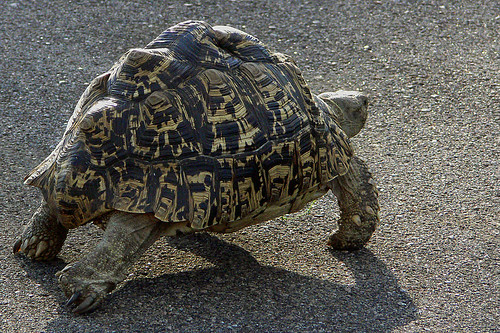

這是一篇發表在Journal of Anatomy 213 (2): 159 - 172的有趣文章. 陸生龜類的前肢通常被認為用以支稱身體, 而水生龜類則多半使用前肢在划水上. 這篇文章的作者提出兩個假說. 也就是說 (1) 水生與陸生龜類會顯示完全不同的前肢肌肉排列, 而水生種類的前肢肌肉束應較為複雜以因應複雜的水中運動; 或者 (2) 陸生種類應具有較發達的肌肉束以支持牠們的體重. 他們挑選了數種水生與半水生龜 (阿根廷側頸龜, 忍者龜, 裏海澤龜, 馬來箱龜, 四眼龜, 巴西龜)以及數種陸生與半陸生龜(智利陸龜, 歐洲陸龜, 花背箱龜, 木紋龜, 華麗箱龜與卡羅萊納箱龜)進行前肢肌肉的解剖與比較. 作者想要瞭解的是前肢結構的差異倒底與環境或演化上的限制較有關聯? 結果他們發現兩種陸龜的前肢肌肉與其它種類全然不同, 出現許多肌肉束的癒合現象, 而卡箱雖然具有類似的肌肉排列, 然其肌腱則沒有陸龜科種類發達. 至於木紋龜則介於水生與陸生種類間. 不過這篇文章最大的問題是受試物種的分群. 而且這篇文章最後的討論完全偏離演化的架構, 也未參考近年有關龜鱉類親緣關係的研究, 因此最後只變成一個比較解剖學研究, 但談不上這樣的比較倒底有什麼演化的義涵.
The distal forelimb musculature in aquatic and terrestrial turtles: phylogeny or environmental constraints?
Virginia Abdala 1 , Adriana S. Manzano 2 and Anthony Herrel 3,4
1 Instituto de Herpetología, Fundación Miguel Lillo-CONICET, Fac. de Cs. Naturales (UNT) Miguel Lillo 251 4000 Tucumán, Argentina
2 CICyTTP-CONICET, Matteri y España (3105), Diamante, Entre Ríos, Argentina
3 Department of Ecology & Organismal Biology, Harvard University, Cambridge, MA, USA
4 Department of Biology, Laboratory of Functional Morphology University of Antwerp, Belgium Correspondence Dr Virginia Abdala, Instituto de Herpetología, Fundación Miguel Lillo-CONICET, Fac. de Cs. Naturales (UNT) Miguel Lillo 251 4000 Tucumán, Argentina.
ABSTRACT We compared the muscular anatomy of the distal front limb in terrestrial and aquatic chelonians to test whether observed differences between the two groups are associated with their divergent lifestyles and locomotor modes. Given the different use of the forelimb in the two environments (body support and propulsion on land vs. mainly propulsion in water) we expected that: (1) aquatic and terrestrial turtles would show differences in their muscular anatomy, with aquatic species having more individualized muscle bundles to allow for the complex forearm movements observed during swimming, and (2) that terrestrial turtles would have more robust muscles to support their body weight against gravity. To address these questions, we examined the forelimb myology and associated tissues in six aquatic or semi-aquatic turtles (Phyrnops hilarii, Podocnemis unifilis, Trachemys scripta, Sacalia bealei, Cuora amboinensis and Mauremys caspica) and six terrestrial or semi-terrestrial turtles (Geochelone chilensis, Testudo graeca, Cuora galbinifrons, Glyptemys insculpta, Terrapene carolina and Rhinoclemmys pulcherrima). This paper describes the general structure of the forelimb musculature in all species, and quantifies muscle masses in those species with more than five specimens available (Ph. hilarii, Po. unifilis and Ge. chilensis). The general structure of the forelimb muscles in the strictly terrestrial species Ge. chilensis and Tes. graeca was found to be notably different from the pattern of the aquatic and semi-aquatic species examined, showing a distinct fusion of the different muscular bodies. Ter. carolina also show a distinctly terrestrial pattern, but a less extensive tendon development. R. pulcherrima and Gl. insculpta were found to be morphologically intermediate; in the geoemydids the strictly terrestrial bauplan never appears. Quantitative differences in the robustness or mass of the distal forelimb muscles were also observed for the species investigated, supporting our prediction that the extensor muscles are more robust in terrestrial turtles. However, in contrast to our expectations, not only the extensor muscles of the distal forelimb (which are crucial in providing both body support and propulsion), but all muscles acting around the wrist were found to be heavier in terrestrial turtles.
圖片連結: Arno & Louise以及doncon402之flickr相簿
The distal forelimb musculature in aquatic and terrestrial turtles: phylogeny or environmental constraints?
Virginia Abdala 1 , Adriana S. Manzano 2 and Anthony Herrel 3,4
1 Instituto de Herpetología, Fundación Miguel Lillo-CONICET, Fac. de Cs. Naturales (UNT) Miguel Lillo 251 4000 Tucumán, Argentina
2 CICyTTP-CONICET, Matteri y España (3105), Diamante, Entre Ríos, Argentina
3 Department of Ecology & Organismal Biology, Harvard University, Cambridge, MA, USA
4 Department of Biology, Laboratory of Functional Morphology University of Antwerp, Belgium Correspondence Dr Virginia Abdala, Instituto de Herpetología, Fundación Miguel Lillo-CONICET, Fac. de Cs. Naturales (UNT) Miguel Lillo 251 4000 Tucumán, Argentina.
ABSTRACT We compared the muscular anatomy of the distal front limb in terrestrial and aquatic chelonians to test whether observed differences between the two groups are associated with their divergent lifestyles and locomotor modes. Given the different use of the forelimb in the two environments (body support and propulsion on land vs. mainly propulsion in water) we expected that: (1) aquatic and terrestrial turtles would show differences in their muscular anatomy, with aquatic species having more individualized muscle bundles to allow for the complex forearm movements observed during swimming, and (2) that terrestrial turtles would have more robust muscles to support their body weight against gravity. To address these questions, we examined the forelimb myology and associated tissues in six aquatic or semi-aquatic turtles (Phyrnops hilarii, Podocnemis unifilis, Trachemys scripta, Sacalia bealei, Cuora amboinensis and Mauremys caspica) and six terrestrial or semi-terrestrial turtles (Geochelone chilensis, Testudo graeca, Cuora galbinifrons, Glyptemys insculpta, Terrapene carolina and Rhinoclemmys pulcherrima). This paper describes the general structure of the forelimb musculature in all species, and quantifies muscle masses in those species with more than five specimens available (Ph. hilarii, Po. unifilis and Ge. chilensis). The general structure of the forelimb muscles in the strictly terrestrial species Ge. chilensis and Tes. graeca was found to be notably different from the pattern of the aquatic and semi-aquatic species examined, showing a distinct fusion of the different muscular bodies. Ter. carolina also show a distinctly terrestrial pattern, but a less extensive tendon development. R. pulcherrima and Gl. insculpta were found to be morphologically intermediate; in the geoemydids the strictly terrestrial bauplan never appears. Quantitative differences in the robustness or mass of the distal forelimb muscles were also observed for the species investigated, supporting our prediction that the extensor muscles are more robust in terrestrial turtles. However, in contrast to our expectations, not only the extensor muscles of the distal forelimb (which are crucial in providing both body support and propulsion), but all muscles acting around the wrist were found to be heavier in terrestrial turtles.
圖片連結: Arno & Louise以及doncon402之flickr相簿
